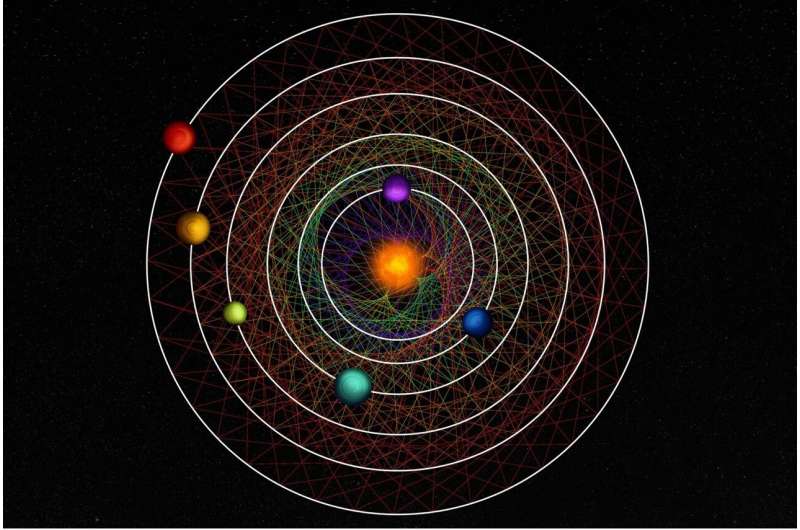This article has been reviewed according to Science X's editorial process and policies. Editors have highlighted the following attributes while ensuring the content's credibility:
fact-checked
peer-reviewed publication
trusted source
proofread
Scientists discover rare six-planet system that moves in strange synchrony

Scientists have discovered a rare sight in a nearby star system: Six planets orbiting their central star in a rhythmic beat. The planets move in an orbital waltz that repeats itself so precisely that it can be readily set to music.
A rare case of an "in sync" gravitational lockstep, the system could offer deep insight into planet formation and evolution.
The analysis, led by UChicago scientist Rafael Luque, was published Nov. 29 in Nature.
"This discovery is going to become a benchmark system to study how sub-Neptunes, the most common type of planets outside of the solar system, form, evolve, what are they made of, and if they possess the right conditions to support the existence of liquid water in their surfaces," said Luque.
A rare resonance
The six planets orbit a star known as HD110067, which lies around 100 light-years away in the northern constellation of Coma Berenices.
In 2020, NASA's Transiting Exoplanet Survey Satellite (TESS) detected dips in the star's brightness that indicated planets were passing in front of the star's surface. Combining data from both TESS and the European Space Agency's CHaracterizing ExOPlanet Satellite (Cheops), a team of researchers analyzed the data and discovered a first-of-its-kind configuration.
While multi-planet systems are common in our galaxy, those in a tight gravitational formation known as "resonance" are observed by astronomers far less often.
In this case, the planet closest to the star makes three orbits for every two of the next planet out—called a 3/2 resonance—a pattern that is repeated among the four closest planets. Among the outermost planets, a pattern of four orbits for every three of the next planet out (a 4/3 resonance) is repeated twice.
And these resonant orbits are rock-solid: The planets likely have been performing this same rhythmic dance since the system formed billions of years ago, the scientists said.
Formation stories
Orbitally resonant systems are extremely important to find because they tell astronomers about the formation and subsequent evolution of the planetary system. Planets around stars tend to form in resonance but can be easily perturbed. For example, a very massive planet, a close encounter with a passing star, or a giant impact event can all disrupt the careful balance.
As a result, many of the multi-planet systems known to astronomers are not in resonance but look close enough that they could have been resonant once. However, multi-planet systems preserving their resonance are rare.
"We think only about one percent of all systems stay in resonance, and even fewer show a chain of planets in such configuration," said Luque. That why HD110067 is special and invites further study: "It shows us the pristine configuration of a planetary system that has survived untouched."
More precise measurements of these planets' masses and orbits will be needed to further sharpen the picture of how the system formed.
More information: Rafael Luque, A resonant sextuplet of sub-Neptunes transiting the bright star HD 110067, Nature (2023). DOI: 10.1038/s41586-023-06692-3. www.nature.com/articles/s41586-023-06692-3
Journal information: Nature
Provided by University of Chicago





















